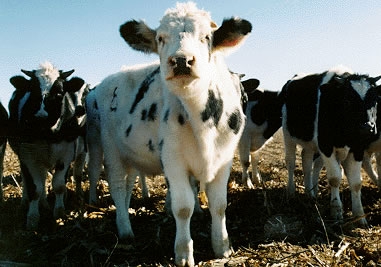Posts Tagged: global warming
Pollution regulations stymie dairy electricity generation
For Central Valley dairies, conflicting laws are making it hard to generate green electricity from dairy waste, according to an article this week in the Los Angeles Times.
In order to reduce emissions of methane - a greenhouse gas - some dairy operators have installed methane digesters that convert the methane into electricity.
However, the process produces nitrogen oxides (NOx), which react with volatile organic compounds to create ozone, a significant air pollution problem in the San Joaquin Valley. NOx levels for the valley, a region with air pollution among the most severe in the country, is set by federal officials and enforced by the San Joaquin Valley Air Pollution Control District.
The district is requiring expensive modifications on digesters, which in some cases shuts the equipment down altogether. Air district officials told the LA Times they're just doing their jobs. "Combating smog, not climate change, is the agency's mission," Times reporter P.J. Huffstutter wrote.
Modesto dairy operator John Fiscalini spent hundreds of thousands of dollars on a catalytic converter and other filtering equipment to meet the air district's limit of 11 parts per million of NOx for his digester system.UC Davis Cooperative Extension animal scientist Frank Mitloehner told the Times that works out to equal the emissions of 26 cars for every 1,000 cows.
"They have a point. I want clean air," Visalia dairy farmer Ron Koetsier was quoted in the story. "But it doesn't make financial sense for me keep doing this. I don't see how they can turn methane gas into electricity in California, given these rules."

Dairy cow in California.
Ag must adjust as population grows and world warms
With the world facing serious challenges - like global warming, diminishing fresh water supplies and population growth - there is a critical need for people to get beyond biases against the use of agricultural biotechnology, according to a group of prestigious scientists that includes UC Davis plant pathologist Pamela Ronald.
This admonition was part of a perspective piece published in the Feb. 12 issue of the journal Science. The authors also said there is an increasing need for development of farming systems that use saline water and integrate nutrient flows.
In the Science article, the researchers noted that crop reductions related to global climate change are already apparent. For example, a 2003 heat wave in Europe, which caused a 3.5-degree rise in the average summer temperature, killed 30,000 to 50,000 people and resulted in a 20 to 36 percent decrease in the yields of grains and fruit that summer.
"That dramatic drop in yield is just a foreshadowing of the challenges that lie ahead for agriculture during the 21st century, as temperatures rise and another 3 billion people are added to the global population," Ronald was quoted in a UC Davis news release about the journal article.Ronald believes global warming will change the pattern of plant diseases and cause intense, periodic flooding.
"The good news is that we have the ability, through conventional breeding and genetic engineering, to generate new varieties of our existing food crops that can better adapt to these environmental changes," Ronald was quoted.

Pamela Ronald
UC helps Marin dairy operators clear the air
UC Cooperative Extension provided Marin ranchers and dairy operators exposure at a two-hour workshop Feb. 2 to the latest conservation practices that can help the agriculture industry reduce its environmental impacts and increase farm and ranch energy efficiency.
In addition to local farmers, reporter Rob Rogers was at the event collecting information for an article published in the Marin Independent Journal yesterday.Rogers reported that cows produce a smaller percentage of greenhouse gases in the United States and Europe than in other nations, where farming is a larger part of the economy, and where it's practiced less efficiently. According to the United Nations, livestock produce about 18 percent of the world's greenhouse gasses. In the U.S., livestock is responsible for just 5.8 percent of total greenhouse gas emissions.
Workshop speaker Frank Mitloehner, UC Davis air quality specialist, said research shows that it is cows - not waste storage lagoons - that emit most methane and nitrous oxide on dairies.
"Lagoon waste is so heavily diluted that it's a smaller factor than fresh waste," Mitloehner was quoted in the story.
He offered solutions that may not sit well with organic producers:
-
Produce more milk with fewer cows by increasing efficiency.
-
Cut back on grass-fed cattle, which, because of extra roughage, produce more methane.
Albert Strauss, an organic dairy farmer who also spoke at the meeting, noted that reducing cow emissions is only part of the environmental picture. One option for reducing dairy emissions is converting waste into energy with a methane digester. Using this technology, the Strauss operation meets its own energy needs and will soon be selling extra energy back to PG&E, the article said.

dairycow
Going beyond the green bag
When the earth is passed on to the next generation, will those who last inhabited the space do so with any regrets? This grand question was asked by the director of UC's Agricultural Sustainability Institute, Tom Tomich, in an op-ed piece published in yesterday's Huffington Post.
Leaving with "no regrets," he wrote, goes beyond cloth grocery bags and compact fluorescent light bulbs. And for the ag community, "no regrets" strategies are particularly important.
"Agriculture is the largest industry in California and is among the most vulnerable to climate fluctuations," Tomich wrote. "Climate's impacts on our farms and ranches directly affect our economy, jobs and our food supply."
Tomich's essay touched on three key areas where agriculture impacts environment:
- Water - Farmers need the technology to produce more food with less water, homeowners and business should continue to increase water efficiency and water should be left over to ensure healthy rivers.
- Energy and nitrogen fertilizer - Nitrogen fertilizer helped drive spectacular increases in food production, but manufacturing the fertilizer gobbles energy. The nitrogen also holds risks as a greenhouse gas and source of water pollution.
- Farmland preservation and healthy children - Preservation of farmland could reduce sprawl and perhaps, along with "smart growth," foster walkable communities in the West.
Tomich said the "no regrets" strategies require Americans to raise their awareness about the links between food, agriculture and climate and he praised California's leadership on the issue, which was demonstrated by passage of the state's Global Warming Solutions Act in 2006.
"California's actions can't substitute for a comprehensive global approach," Tomich concluded, "but they are a start we won't regret."

Tom Tomich
Media look to agriculture for global warming relief
As protests at the Copenhagen "climate summit" heat up and talks reach a critical stage, the media are looking at a variety of ways humans can slow carbon emissions into the atmosphere, such as changing the way we farm.
In an Ask Pablo column on a Web site called Treehugger, writer Pablo Paster considers whether people should go back to using horses instead of tractors to farm. At first glance, I thought the piece was meant to be humorous, but in fact, Paster researched whether such a change would reduce greenhouse gas emissions.
Among the data Paster used to support the idea was a 2008 UC Davis Cooperative Extension cost study on wheat production. The columnist noted that UC scientists determined it takes 5.43 gallons of fossil fuels per acre to produce 3.25 tons of wheat.
"When combusted this fuel turns into 122 pounds of carbon dioxide (CO2). Although this number is not going to be the same for every crop we can assume that it is within the right range for all grain crops," Paster wrote.
Combining this information with other data he collected, Paster concluded that tractors emit 122 pounds of CO2 per acre compared to the 21.5 pounds of indirect emissions from the horse. "If the horse feed were also cultivated by horses this number would be even smaller," Paster wrote.
He acknowledged the difficulty of producing all the world's food using horses, but said small-scale, organic farms could find many advantages to using draft horses.
"Horses have a lower upfront cost and their fuel (feed) also costs less, they tread lightly on the ground, and they even bring their own fertilizer to the fields," he wrote.
Meanwhile, National Public Radio reporter Christopher Joyce joined UC Berkeley environmental science professor Whendee Silver on a visit to a Marin County research site where she is looking at the use of compost on rangeland to increase its carbon-holding capacity.
The compost, a mix of plant clippings and animal manure, "increases plant growth, it actually also lowers the temperature a little bit, so the soil doesn't get quite as hot, it doesn't stimulate as much microbial activity."
The taller grass and minimized soil activity mean the acreage stores more carbon.
"Hopefully, (farmers will) be able to participate in a carbon market, where we can quantify how much carbon is being stored on the land, and they can sell that as a carbon offset," Silver told the reporter.
